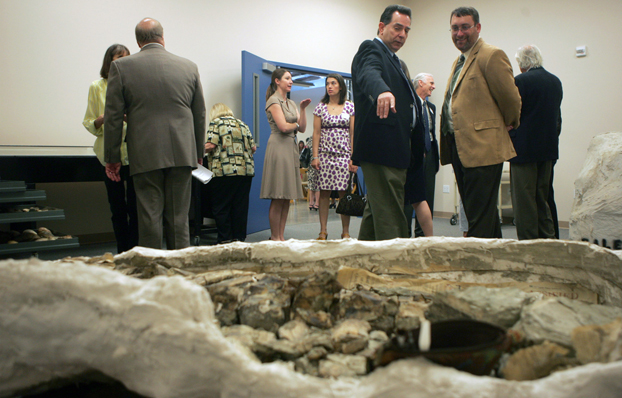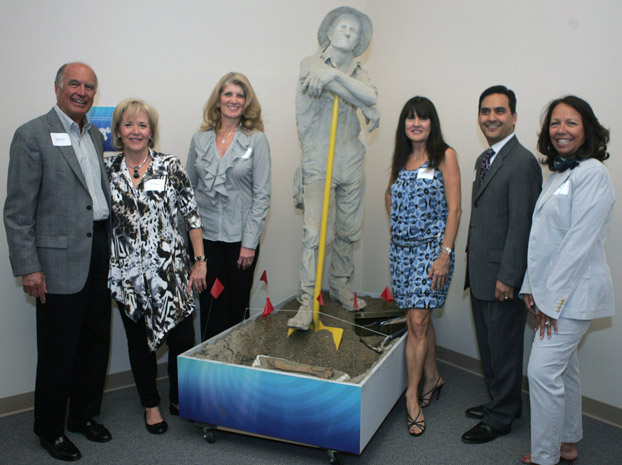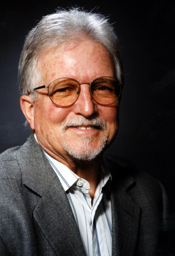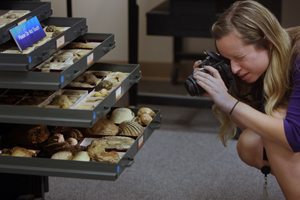 Caption: The Orange County Board of Supervisors and Cal State Fullerton opened the John D. Cooper Archaeological and Paleontological Center in Santa Ana on May 4. Photo by Karen Tapia
Caption: The Orange County Board of Supervisors and Cal State Fullerton opened the John D. Cooper Archaeological and Paleontological Center in Santa Ana on May 4. Photo by Karen Tapia
University Initiative
A Look Back at OC History
Cooper Center Offers Research, Curation, Education
THE FOSSILS OF PREHISTORIC animals and plants, sherds of pottery, projectiles, tools, stones molded into mortars and pestles. These items wait to be studied and have their stories unfurl. Soon the tales of the county’s earliest inhabitants will be told, thanks to the establishment of the John D. Cooper Archaeological and Paleontological Center.
Located in Santa Ana, teams of Cal State Fullerton professors, students, archaeologists, paleontologists, geologists and volunteers will be able to expand their research into the county’s earliest history. In partnership with the County of Orange, the university has embarked on an ambitious project to study the artifacts and fossils found within the borders of Orange County and nearby regions to determine what life was like in the ancient OC.
Referred to as the Cooper Center, the facility is named after CSUF’s pioneering geology professor John D. Cooper, who envisioned just such a center prior to his death in 2007. The facility will provide anthropologists and paleontologists with the structure and supplies they need to curate the rare artifacts and fossils that have been found.
“Many of our finds are a result of development,” said David Bowman, chair and professor of geological sciences. “Prior to building, developers prepare the soil for new structures and they are required to call in a team of scientists including archaeologists and geologists to determine if there are any artifacts of historical or scientific significance. If they find something, a team will remove it and store it for future study.”
“Right now, we have thousands of artifacts and fossils in storage because we needed a facility where we could work and curate this amazing collection,” said Bowman. “That is what the Cooper Center will provide.”
While the fossils and artifacts are not the property of the university, the County of Orange and OC Parks has entrusted the stewardship of these items to Cal State Fullerton.
“The partnership is very exciting,” Bowman said. “The county provides the physical structure and we provide the geologists and anthropologists, researchers, students and volunteers who will curate these finds.”
 Caption: Members of CSUF’s Philanthropic Foundation Board enjoy learning more about the John D. Cooper Center during the ribbon-cutting ceremony. From left: Dick Ackerman, Verne Wagner, Jo E. Bandy, Annette Feliciani, Jose Lara and Victoria Vasques. Photo by Karen Tapia
Caption: Members of CSUF’s Philanthropic Foundation Board enjoy learning more about the John D. Cooper Center during the ribbon-cutting ceremony. From left: Dick Ackerman, Verne Wagner, Jo E. Bandy, Annette Feliciani, Jose Lara and Victoria Vasques. Photo by Karen Tapia
The Mystery of the Cog Stones
“The collection itself is huge,” said Ed Knell, assistant professor of anthropology. “With the involvement of the university, we will be able to organize and preserve these artifacts in a way that sheds light on the earliest inhabitants of the region.“
The archeological artifacts provide a portrait of sophisticated people as early as 11,000 years ago.
“This is the record of the county’s history and once these items are gone, we lose a valuable part of that record,” Knell explained. “By studying collections like those at the Cooper Center, archaeologists can learn much about the different populations that inhabited the west coast.”
For instance, researchers know that early Indian tribes traveled far more extensively than was previously believed based on the types of items found at the Cooper Center — many of which might have been used for trading purposes.
“We currently have more than 3,000 boxes of artifacts,” said Elizabeth
Sutton, associate curator, archaeology. “We are starting to go through
and examine and catalog the artifacts. Much of what we’re finding
hasn’t been studied and we are excited about being able to learn more
about the prehistoric inhabitants of on the west coast.”
Already, students and researchers are studying beads, baskets, tools,
and learning more about the early Indian tribes in this region.
“We believe Orange County may have been a place where several Native American groups interacted,” Sutton said. “We can determine how tribes traded and learned skills from one another through what we find. With this collection available, we’re eager to learn more.”
One of the puzzles in the Orange County collection is a collection of cog stones. These carved stones tend to be found along the west coast and nobody is quite sure of their intended purpose, although many suspect they were used as some sort of ceremonial artifact.
“We know that some early Native American tribes stayed in place and we
are learning more about the tribes that traveled,” said Knell. “Based
on where we find similar types of artifacts made from the same raw
material sources where the stone was procured to make their tools, we
can track the different travel routes of these tribes. In the southwest
region of the country, we find a lot of rock art — painting. We don’t
find a lot of rock art in Orange County but we do have the cog stones
and they have a story to tell."
There are also projectile points — some up to 7,000 years old — and early ceramics as well as adobe bricks and metal tools.
“These artifacts tell us the stories. They’re a mystery and it’s our job, as archaeoologists to study them, their placement, the types of stones and materials used to create these objects, and their ages to try to determine how these tribes lived on the west coast.”
Currently, three CSUF interns are working with the artifacts, learning curation techniques and furthering our understanding of the region.
“If you like mysteries, you’ll like archaeology,” said Knell. “We’re looking at artifacts and trying to piece together stories of a culture and civilization based on what we find.”
Stories from the Ocean
Over in the paleontology area, scientists are working on the bones of whales, walruses, deer and other prehistoric animals.
“The west coast is a fascinating place because we find evidence of both marine and terrestrial animals,” said Meredith Rivin, associate curator, paleontology. “With early Miocene whales, there are a handful of sites elsewhere in the world that have these whales. And of those sites, they only have a handful of specimens. At just one site in Orange County there are between 11 and 13 new species of early Miocene whales. This will triple what’s known elsewhere about these mammals.”
While conducting her research, Rivin discovered transitional species that have characteristics of a common ancestor between baleen whales and toothed whales (dolphins and porpoises) that are younger than previous known examples.
“We see species here that were extinct elsewhere in the world,” she said.
In addition to marine mammals such as whales, porpoises and sea lions not found anywhere else, the collection contains a wealth of fossils that span back to the age of dinosaurs. Cretaceous seas with ammonites – coiled cephalopods similar in appearance to the modern nautilus – gave way to coastal lowlands inhabited by early rhinoceroses, camels, bears, and primates. During the Pleistocene era, Orange County was inhabited by mammoths, mastodons, giant ground sloths, and saber toothed cats.
“We have fossils here that are more than 150 million years old,” she said. “By studying paleontology, we can see how certain species died off or evolved.”
“This is an incredible collection and we are all very happy at the prospect of being able to study and curate it in great detail,” Bowman added.
May 19, 2011
 Much of the time, you could find
Much of the time, you could find  Kristi Bergstrom takes photos during the recent opening of the John D. Cooper Archaeological and Paleontological Center in Santa Ana. Photo by Karen Tapia
Kristi Bergstrom takes photos during the recent opening of the John D. Cooper Archaeological and Paleontological Center in Santa Ana. Photo by Karen Tapia